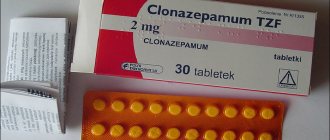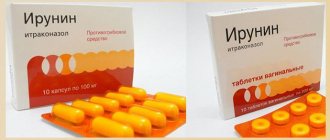Pharmacological properties of the drug Mikomax
fluconazole is an antifungal drug, a triazole derivative. It specifically inhibits the synthesis of ergosterol in the cell membranes of micromycetes through inhibition of cytochrome P450. The high specificity of the drug causes a slight and clinically insignificant blockade of this enzyme in humans (100 times weaker than that of ketoconazole). The most sensitive to fluconazole are fungi of the genus Candida, Cryptococcus, Microsporum and Trichophyton . Fluconazole is also effective against endemic mycoses, such as infections caused by Blastomyces dermatitidis, Coccidiodes immutis (including intracranial infections) and Hystoplasma capsulatum . Candida krusei and Candida glabrata remain resistant to the drug ; in addition, fluconazole is ineffective against aspergillosis and zygomycosis. The pharmacokinetic properties of fluconazole are the same when administered intravenously and orally. Fluconazole is well absorbed from the gastrointestinal tract, and its plasma concentration (as well as bioavailability) is 90% of the level observed with intravenous administration. Taking the drug with food does not affect its absorption. After administration on an empty stomach, the maximum concentration of fluconazole in the blood plasma is achieved after 30–90 minutes, and the half-life is 30 hours. The concentration of fluconazole in the blood plasma is proportional to the dose taken. When taking fluconazole once a day, its concentration in the blood plasma stabilizes at 90% of the maximum on the 4th–5th day of treatment. If on the 1st day of treatment you take a double daily dose at once, then this concentration is achieved already on the 2nd day. The volume of distribution of the drug approaches the total volume of water in the body. Binding to blood plasma proteins is insignificant - 11–12%. Fluconazole penetrates into all tissues and fluids of the body. It is excreted mainly by the kidneys almost completely unchanged. Fluconazole clearance is directly proportional to creatinine clearance.
Pharmacokinetics and pharmacodynamics
Fluconazole is a common synthetic drug from the triazole group. This drug has a highly specific effect, inhibits the activity of fungal enzymes dependent on hemoprotein P450. The substance helps to increase the permeability of the plasma membranes of pathogenic microorganisms, disrupts the process of cell division and stops the conversion of lanosterol to ergosterol. It is noteworthy that the drug has a selective effect and almost does not inhibit P450 enzymes in the human body (unlike Clotrimazole, Ketoconazole and Econazole). It does not have antiandrogenic activity.
When taken orally, Mycomax is well absorbed without changing its antifungal properties under the influence of food. The maximum content of fluconazole in the blood plasma is observed 30−90 minutes after administration, and the equilibrium level (approximately 90%) is achieved on days 4−5 of therapy.
Preparations of the triazole group, including Mycomax, have the property of penetrating into all body fluids, including synovial, spinal, sweat and peritoneal, as well as breast milk, saliva and sputum. The constant presence of fluconazole in vaginal secretions is observed 8 hours after oral administration and remains at this level for at least a day.
The substance suppresses the activity of the CYP2C9 isoenzyme in the liver and is excreted from the body mainly by the kidneys (11% in the form of metabolites and 80% unchanged). The removal process takes about 30 hours. Pharmacokinetics largely depends on the functional state of the kidneys. For example, within three hours after hemodialysis, the fluconazole content in plasma is reduced by half.
Indications for use of the drug Mycomax
Treatment and prevention of fungal infections. Cryptococcosis (cryptococcal meningitis and other forms of this infection, such as pulmonary, skin). The drug is used to treat patients with both normal and weakened immune systems due to HIV infection, organ transplantation or other conditions. Fluconazole can be used for the maintenance treatment of cryptococcal infection in patients with AIDS. Systemic candidiasis , including candidemia, disseminated candidiasis, including damage to the abdominal organs, endocardium, eyes, lungs, urinary tract, liver, spleen and other organs. This drug is primarily indicated for the treatment of cancer patients receiving cytostatics or immunosuppressants. Candidiasis of the mucous membranes - oropharyngeal, esophageal, non-invasive bronchopulmonary, candiduria, chronic oral atrophic candidiasis (occurring under dentures). Candidiasis of the genital organs - acute or recurrent (3 or more cases per year) vulvovaginal candidiasis (for recurrent candidiasis, the drug is prescribed for prophylactic purposes), candidal balanitis. Dermatomycosis of the feet, skin, inguinal dermatomycosis, pityriasis versicolor, athlete's foot (onychomycosis) and candidal skin infections. Systemic endemic mycoses in patients with normal immunity, such as coccidioidomycosis, paracoccidioidomycosis, sporotrichosis and histoplasmosis. Treatment can begin even before laboratory results are available. However, after identifying the pathogen, it is necessary to adjust the therapy. The drug Mycomax syrup is used to treat children, adolescents and adults. The drug Mikomax 150 is not used for the treatment of children and adolescents under 16 years of age.
Use of the drug Mycomax
The daily dose of fluconazole and dosage form are selected depending on the type and severity of the fungal infection. Treatment should be continued until clinical and laboratory signs of the disease completely disappear. Stopping treatment prematurely may lead to recurrence of the infection. Patients with AIDS, cryptococcal meningitis, recurrent oropharyngeal candidiasis, or esophageal candidiasis usually require supportive care. If the patient's condition improves, the Mikomax infusion solution can be replaced with an oral dosage form of the drug (Mikomax 150 capsules or Mikomax syrup) in the same dose. Adult patients with normal renal function Treatment For candidemia, disseminated candidiasis and other invasive candidal infections, treatment usually begins with a double dose of the drug (400-800 mg), and then 200-400 mg 1 time per day. Cancer patients after intensive antitumor chemotherapy, patients after bone marrow transplantation, major gastrointestinal or cardiac surgery are usually prescribed a higher initial (10 mg/kg/day) and higher maintenance (approximately 5 mg/kg/day) dose. The duration of treatment depends on the achieved therapeutic effect and is usually 10–14 days; in severe conditions, treatment takes longer. For oropharyngeal candidiasis, 50–100 mg of fluconazole is usually prescribed 1 time/day for 7–14 days. Patients with severe immune impairment are usually given a higher dose (100–200 mg/day) with an increase in the duration of treatment. For atrophic candidiasis of the oral cavity caused by wearing dentures, 50 mg is usually prescribed once a day for 14 days with simultaneous disinfection of the denture with local antiseptics. Adults Vaginal candidiasis: 150 mg once. Trichophytosis of smooth skin, trichophytosis of the perineum: 150 mg once a week for 2–4 weeks. For other candidal infections of the mucous membranes, such as esophagitis, non-invasive bronchopulmonary infections, candiduria, mucocutaneous candidiasis, etc. the effective daily dose is 100–200 mg, and the course of treatment lasts 14–30 days. For cryptococcal meningitis, the loading dose is usually 400–800 mg on day 1; after this, the drug is used in a maintenance dose - 200–400 mg 1 time per day. For other localizations of cryptococcal infection, 400 mg is usually prescribed on the first day of treatment, and then 200–400 mg of fluconazole once a day. The duration of therapy for cryptococcal infections depends on the clinical and mycological response to treatment, and for cryptococcal meningitis it lasts at least 6–8 weeks. For systemic endemic mycoses, 200–400 mg is prescribed daily for up to 2 years. The duration of treatment is individual and for coccidioidomycosis it is approximately 11–24 months, for paracoccidioidomycosis – 2–17 months, for sporotrichosis – 1–16 months and for histoplasmosis – 3–17 months. Prevention In patients with AIDS, relapse of oropharyngeal candidiasis can be prevented by taking 150 mg of fluconazole once a week for a long time (after prescribing the drug in a loading dose). To prevent relapse of cryptococcal meningitis in patients with AIDS, it is advisable to take 200–400 mg of fluconazole daily after a loading dose of the drug. The dose of fluconazole for the prevention of candidiasis depends on the degree of risk of its occurrence and can range from 50 to 400 mg once a day. With an increased risk of disseminated infection, for example in patients with suspected severe and prolonged neutropenia, it is recommended to prescribe 400 mg of fluconazole daily. It is recommended to begin administering the drug before expected neutropenia and continue treatment for another 7 days after the number of neutrophil granulocytes has increased to 1.0 × 109/l. Patients with impaired renal function Fluconazole is eliminated from the body mainly by the kidneys in unchanged form. When treating patients with renal failure with fluconazole, a loading dose of 50–400 mg is first administered, and then (depending on the indications) the dose is halved if the creatinine clearance is less than 50 ml/min (0.8 ml/s). The daily dose is calculated according to the table:
Creatinine clearance (ml/min) | Recommended dose (%) |
| 50 | 100 |
| 11–50 (without dialysis) | 50 |
| Regular dialysis | 100 after each dialysis |
Patients on long-term dialysis must be given a repeat dose of the drug after each session. For long-term arteriovenous (venovenous) hemodialysis, the drug is prescribed in a standard dose. For long-term ambulatory peritoneal dialysis, fluconazole in an amount of 150 mg is added to up to 2 liters of dialysis solution. When creatinine clearance is 50 ml/min (≥0.8 ml/s), the drug is prescribed at the usual dose. When creatinine clearance is 10–50 ml/min (≤0.8 ml/s), it is recommended to halve the dose of the drug. Patients with severe liver dysfunction In patients with severe liver dysfunction, appropriate indicators should be constantly monitored, and if functional tests worsen, the dose of fluconazole should be reduced or treatment with this drug should be stopped altogether. Elderly Patients aged 60 years and older in the absence of signs of kidney dysfunction are prescribed the drug at the usual dose for adults. If renal function is impaired (creatinine clearance ≤50 ml/min, or ≤0.8 ml/s), the drug is prescribed according to the scheme given above. Children Treatment of long-term infections in children, as in adults, depends on the clinical and mycological response to appropriate therapy. When treating children, the maximum daily dose for adults should not be exceeded. For children, fluconazole is administered in 1 dose 1 time per day, although due to the short biological half-life (15.2–17.6 hours), in severe conditions it is more advisable to administer the drug 2 times per day. In this case, the total daily dose of fluconazole for children should not exceed 600 mg. For the treatment of mucosal candidiasis, it is recommended to take the drug at a dose of 3 mg/kg/day. On the 1st day of treatment, it is advisable to prescribe a double dose, that is, 6 mg/kg/day, which will allow achieving a stable concentration of fluconazole in the blood plasma already on the 2nd day of treatment. Treatment of systemic candidiasis and cryptococcal infections requires doses of 6 to 12 mg/kg/day, depending on the severity of the disease. For children with weakened immune systems and an increased risk of neutropenia after chemotherapy or radiation therapy, it is recommended to administer 3–12 mg/kg of the drug daily to prevent fungal infections, depending on the severity and duration of neutropenia (see Dosage in adults). In children with impaired renal function, it is necessary to adjust the daily dose taking into account creatinine clearance (see Patients with impaired renal function). Children under 4 weeks of age In newborns, fluconazole is excreted slowly. In the first 2 weeks of life, the dosage (in mg/kg) is the same as in older children, but the drug is administered after 72 hours. For children aged 2 to 4 weeks, the same dose of fluconazole is administered every 48 hours. Method of administration : Infusion -r Mikomax, contained in 1 bottle, is administered intravenously for at least 60 minutes, and for children - 120 minutes.
The injection rate should not exceed 10 ml/min. 100 ml of infusion solution contains 15.4 mmol of Na+ ions and 15.4 mmol of Cl- ions. Other solutions or medications cannot be added to the Mycomax infusion solution. Mikomax infusion solution is compatible with 5 and 10% glucose solution, Ringer's solution, Hartmann's solution, 4.2% bicarbonate solution, heparin. Remains of unused Mycomax solution must be destroyed in accordance with current instructions. They should not be refrigerated, frozen, or stored for later use.
Release form and composition
The following dosage forms of Mycomax are produced:
- Capsules: with an opaque white body and an opaque blue cap; black markings on the body: 0.1 g each - “MYCO 100”; 0.15 g each – “MYCO 150”; inside the capsules are filled with white with a yellowish tint or almost white powder (0.1 g each: in blisters of 1 or 3 pcs., 1 blister in a cardboard pack; 0.15 g each: in blisters of 1 pc., 1, 4 or 10 blisters in a cardboard pack);
- Syrup: colorless, transparent (in 100 ml bottles with a measuring cup included; 1 set in a cardboard pack);
- Solution for infusion: transparent, colorless (in clear glass bottles of 100 ml; 1 bottle in a cardboard pack).
One capsule contains:
- Active ingredient: fluconazole – 0.1 or 0.15 g;
- Auxiliary components: sodium lauryl sulfate, magnesium stearate, colloidal silicon dioxide, pregelatinized starch, lactose monohydrate;
- Shell: black Attramentum nigrum ink (antifoam DC 1510, soy lecithin, shellac, industrial methylated alcohol, n-butanol, black iron oxide), gelatin, titanium dioxide, Patent blue dye (E131), yellow iron oxide dye.
1 ml of syrup contains:
- Active ingredient: fluconazole – 0.005 g;
- Auxiliary components: purified water, cherry flavor, sodium saccharin, sodium benzoate, citric acid monohydrate, sodium carmellose, glycerol 85%, sorbitol 70% liquid.
1 ml of solution for infusion contains:
- Active ingredient: fluconazole – 0.002 g;
- Auxiliary components: water for injection, sodium chloride.
Side effects of the drug Mycomax
fluconazole is usually well tolerated. Possible gastrointestinal disorders - nausea, abdominal pain, diarrhea and flatulence. The second most common adverse reaction is skin exanthema. Taking fluconazole may cause headaches. In some patients (usually with a severe underlying disease such as AIDS or a malignant tumor) during treatment with fluconazole or another similar drug, the following were observed: impaired renal function, blood counts, liver function tests (see SPECIAL INSTRUCTIONS), seizures, leukopenia, thrombocytopenia and alopecia. If exanthema occurs in patients with superficial mycoses, the appearance of which is associated with the administration of fluconazole, then treatment with the drug must be stopped. If exanthema appears in a patient with invasive mycosis, it is necessary to conduct a thorough examination, and if there are signs of bullous dermatitis, treatment with fluconazole should be stopped immediately. Anaphylactic reactions after fluconazole, as after other azole compounds, are very rare. With intravenous administration of fluconazole, irritation of the vein in the proximal direction from the injection site may occur, accompanied by redness of the skin and pain (the number of such cases is proportional to the speed of administration of the infusion solution). These phenomena disappear within a few hours after infusion or when changing the site of drug administration and, as a rule, do not require cessation of treatment. In extremely rare cases, thrombophlebitis has been reported.
Side effects
Syrup:
- Digestive system: flatulence, taste changes, nausea, diarrhea, vomiting, abdominal pain; rarely - liver dysfunction (hyperbilirubinemia, increased activity of alanine aminotransferase, aspartate aminotransferase, alkaline phosphatase, hepatonecrosis, hepatitis, jaundice);
- Nervous system: dizziness, headache; rarely – convulsions;
- Hematopoietic organs: rarely - agranulocytosis, neutropenia, thrombocytopenia, leukopenia;
- Allergic reactions: skin rash; rarely - toxic epidermal necrolysis, anaphylactoid reactions, malignant exudative erythema;
- Others: rarely - hypercholesterolemia, renal dysfunction, hypertriglyceridemia, hypokalemia, alopecia.
Solution:
- Central nervous system: headache, dizziness;
- Digestive system: liver failure (hepatocellular necrosis up to death, jaundice, increased bilirubin in the blood, hepatitis, increased activity of alkaline phosphatase and aminotransferase), abdominal pain, change in taste, nausea, flatulence, vomiting, diarrhea;
- Urinary system: renal failure;
- Cardiovascular system: ventricular fibrillation/flutter, increased QT interval;
- Metabolism: hypokalemia, hypercholesterolemia, convulsions, hypertriglyceridemia;
- Hematopoietic system: neutropenia, leukopenia, agranulocytosis, thrombocytopenia;
- Dermatological reactions: skin rash, alopecia;
- Allergic reactions: anaphylactoid reactions, toxic epidermal necrolysis, Stevens-Johnson syndrome.
Capsules:
- General disorders: uncommon – fever, muscle weakness, motor restlessness, weakness;
- Nervous system: often – headache; uncommon – vertigo, dizziness, tremor, convulsions, paresthesia;
- Skin and subcutaneous tissues: often – skin rash; uncommon – increased sweating, itching; rarely – Stevens-Johnson syndrome;
- Gastrointestinal tract: often – diarrhea, nausea, abdominal pain, vomiting; uncommon – changes in taste, anorexia, dry oral mucosa, constipation, flatulence, dyspepsia;
- Musculoskeletal and connective tissue: uncommon – myalgia;
- Mental disorders: infrequently – insomnia, drowsiness;
- Liver and biliary tract: often - increased activity of alkaline phosphatase, clinically significant increase in the activity of aspartate aminotransferase, alanine aminotransferase; uncommon – hyperbilirubinemia, cholestasis, jaundice, liver tissue damage; rarely – liver necrosis;
- Blood and lymphatic system: uncommon – anemia;
- Immune system: rarely – anaphylaxis.
Side effects when taking capsules noted in post-marketing studies:
- Nervous system: rarely – seizures;
- Skin and subcutaneous tissues: rarely – alopecia; very rarely - exudative erythema multiforme, exfoliative skin lesions (Stevens-Johnson syndrome, toxic epidermal necrolysis);
- Liver and biliary tract: rarely - liver necrosis, including death, hepatitis, liver failure;
- Immune system: very rarely - facial swelling, anaphylaxis, itching, angioedema; unknown frequency - anaphylactoid reactions;
- Blood and lymphatic system: rarely - thrombocytopenia, leukopenia (including neutropenia and agranulocytosis);
- Metabolism and nutrition: rarely – hypokalemia, hypertriglyceridemia, hypercholesterolemia;
- Kidneys and urinary tract: unknown frequency - renal dysfunction.
Special instructions for the use of the drug Mikomax
Taking fluconazole in very rare cases can cause severe toxic damage to the liver, sometimes incompatible with life. For such toxic effects, no dependence on the daily dose, duration of treatment, gender or age of the patient was established. However, patients with severe clinical conditions (AIDS, malignant diseases) are at greatest risk. After cessation of fluconazole treatment, liver function usually recovers. It is necessary to carefully monitor the condition of patients who have abnormal values of liver function tests during treatment with fluconazole, and, if necessary, promptly stop administering this drug. Sometimes allergic skin reactions may occur during treatment with fluconazole. Cases of exanthema with the appearance of an exfoliative skin reaction, such as Stevens-Johnson syndrome and toxic epidermal necrolysis, are usually noted only in patients with AIDS. If a patient with superficial mycosis of the skin develops exanthema, which may be caused by fluconazole, then treatment with this drug must be stopped. The condition of patients with invasive or systemic mycosis should be carefully monitored; if bullous dermatitis or erythema multiforme occurs, treatment with fluconazole should be discontinued immediately. Depending on the severity of the disease and clinical course, it may be necessary to switch to parenteral administration of the drug. In case of transition from intravenous administration to oral administration, there is no need to change the daily dose of the drug. Use during pregnancy and lactation is contraindicated, except in cases of fungal infections that threaten the life of the mother, when the expected benefit justifies the possible risk to the fetus. Fluconazole passes into breast milk, so if it becomes necessary to prescribe the drug to the mother, breastfeeding should be stopped.
Contraindications
General contraindications to the use of all dosage forms of Mycomax are:
- Concomitant use with terfenadine, astemizole and other drugs that prolong the QT interval;
- Breastfeeding period;
- Hypersensitivity to the components of the drug or azole compounds similar in structure.
The drug in the form of solution and syrup is contraindicated during pregnancy.
The use of Mycomax capsules is contraindicated: for children weighing up to 40 kg, as well as for glucose-galactose malabsorption, lactase deficiency, congenital galactose intolerance.
Conditions/diseases for which Mikomax syrup is prescribed with caution:
- Liver and/or renal failure;
- Concomitant use of potentially hepatotoxic drugs;
- Alcoholism;
- Children's age up to 6 months.
Conditions/diseases for which Mycomax solution is prescribed with caution:
- Liver failure;
- The occurrence of a rash when taking the drug in patients with invasive/systemic fungal infections and superficial fungal infections;
- Potentially proarrhythmogenic conditions in patients with multiple risk factors (simultaneous use of drugs that cause arrhythmias, electrolyte imbalance, organic heart disease).
Conditions/diseases for which Mycomax capsules are prescribed with caution:
- Liver failure;
- Renal failure (fluconazole dose adjustment required);
- Potentially proarrhythmogenic conditions in patients with multiple risk factors (organic heart disease, water and electrolyte imbalance, concomitant use of medications that cause arrhythmias);
- Concomitant use of terfenadine while taking fluconazole at a dose of less than 0.4 g per day;
- Concomitant use of hypoglycemic agents for oral administration, sulfonylurea derivatives;
- Pregnancy.
Interactions of the drug Mycomax
The following combinations are contraindicated: Cisapride: may slow down the biotransformation of cisapride and thus increase its toxicity. In patients using concomitant cisapride and fluconazole, there have been reports of impaired cardiac function, including ventricular tachycardia, up to the occurrence of serious cardiac arrhythmias. Astemizole, terfenadine - fluconazole may slow down the biotransformation of these antihistamines. Due to the prolongation of the QT and due to the potential risk of malignant arrhythmias, simultaneous administration of these drugs is contraindicated. Concomitant treatment with terfenadine and fluconazole at a dose of more than 400 mg is contraindicated. Drugs that affect the metabolism of fluconazole Hydrochlorothiazide: In a trial in which healthy volunteers were administered hydrochlorothiazide while receiving fluconazole, a 40% increase in fluconazole plasma concentrations was observed. This, however, does not require a dose adjustment of fluconazole in persons taking diuretics. Rifampicin: reduces the biological half-life of fluconazole by approximately 20% and reduces its plasma concentration by 25%. In this case, it is necessary to increase the dose of fluconazole. Effect of fluconazole on the metabolism of other drugs When concomitantly prescribing fluconazole with coumarin anticoagulants, it is necessary to monitor the prothrombin time and the results of other coagulation tests. The simultaneous use of fluconazole during treatment with warfarin increases the prothrombin time by 2 times. Amitriptyline: with simultaneous use of amitriptyline and fluconazole, the concentration of amitriptyline increases and signs of tricyclic toxicity appear. Concomitant use of fluconazole with nortriptyline, the active metabolite of amitriptyline, leads to an increase in nortriptyline levels. Calcium channel antagonists: Dihydropyridine calcium channel antagonists, including nifedipine, isadrin, nicardipine, amlodipine and felodipine, are metabolized via CYP3A4. There is an increase in the concentration of calcium antagonists in the blood serum when they are used simultaneously with fluconazole. Celecoxib: Concomitant use of fluconazole and celecoxib results in increased maximum concentrations and AUC for celecoxib. Midazolam, triazolam: Fluconazole enhances the effect of both drugs. With long-term use, the AUC of midazolam increases by 3.5 times, and triazolam by 2 times (which is accompanied by psychomotor impairment). With a single use of these drugs together with fluconazole, such an interaction does not occur. Cyclosporine: Interaction with cyclosporine occurs at a dose of fluconazole 200 mg. There is an increase in AUC for cyclosporine and a decrease in its clearance by 55%. Fluconazole causes a clinically significant increase in plasma concentrations of cyclosporine A in patients after kidney transplantation. HMG-CoA reductase inhibitors: simultaneous use of fluconazole with HMG-CoA reductase inhibitors increases the risk of myopathy. Due to the interaction of fluvastatin with fluconazole, an individual increase in the AUC for fluvastatin occurs. Losartan: simultaneous use of fluconazole and losartan leads to an increase in the concentration of losartan and a decrease in the concentration of its active metabolite. Phenytoin: Concomitant administration of fluconazole and phenytoin results in a clinically significant increase in phenytoin concentrations. Therefore, it is necessary to monitor the level of this drug in the blood and, if necessary, adjust its dose. Rifabutin: Concomitant use of fluconazole with rifabutin leads to an increase in serum rifabutin levels, which increases the effects of rifabutin, including its toxic effects by 80%. Tacrolimus: simultaneous use of fluconazole and tacrolimus increases the concentration of tacrolimus in the blood plasma with the possible appearance of signs of its toxicity (nephrotoxicity, hyperglycemia, hyperkalemia). When using these drugs simultaneously, it is necessary to monitor the level of tacrolimus in the blood plasma and, if necessary, reduce its dose. Theophylline: fluconazole increases plasma theophylline concentrations; use of fluconazole for 14 days leads to a decrease in plasma clearance of theophylline. When using theophylline in a high dose, it is necessary to promptly recognize signs of its toxicity and reduce the dose. Zidovudine: Fluconazole in high doses (400 mg or more) leads to a clinically significant increase in plasma zidovudine concentrations. Amphotericin B: Given the mechanism of action of these antifungal agents, an antagonistic interaction can be assumed. However, the practical result (antagonistic, additive or synergistic) depends on the type of fungus and the order of drug administration. Medicines containing sulfonylureas: fluconazole increases the plasma concentration and half-life of oral sulfonylurea compounds (glibenclamide, glipizide, tolbutamide). When they are administered simultaneously with fluconazole, it is necessary to carefully monitor blood glucose levels. Oral contraceptives: when used in combination with fluconazole, both increases and decreases in hormone levels (estradiol, levonorgestrel) were noted. When using these drugs simultaneously, it is necessary to carefully monitor the patient's condition due to the possible occurrence of side effects caused primarily by estradiol.










